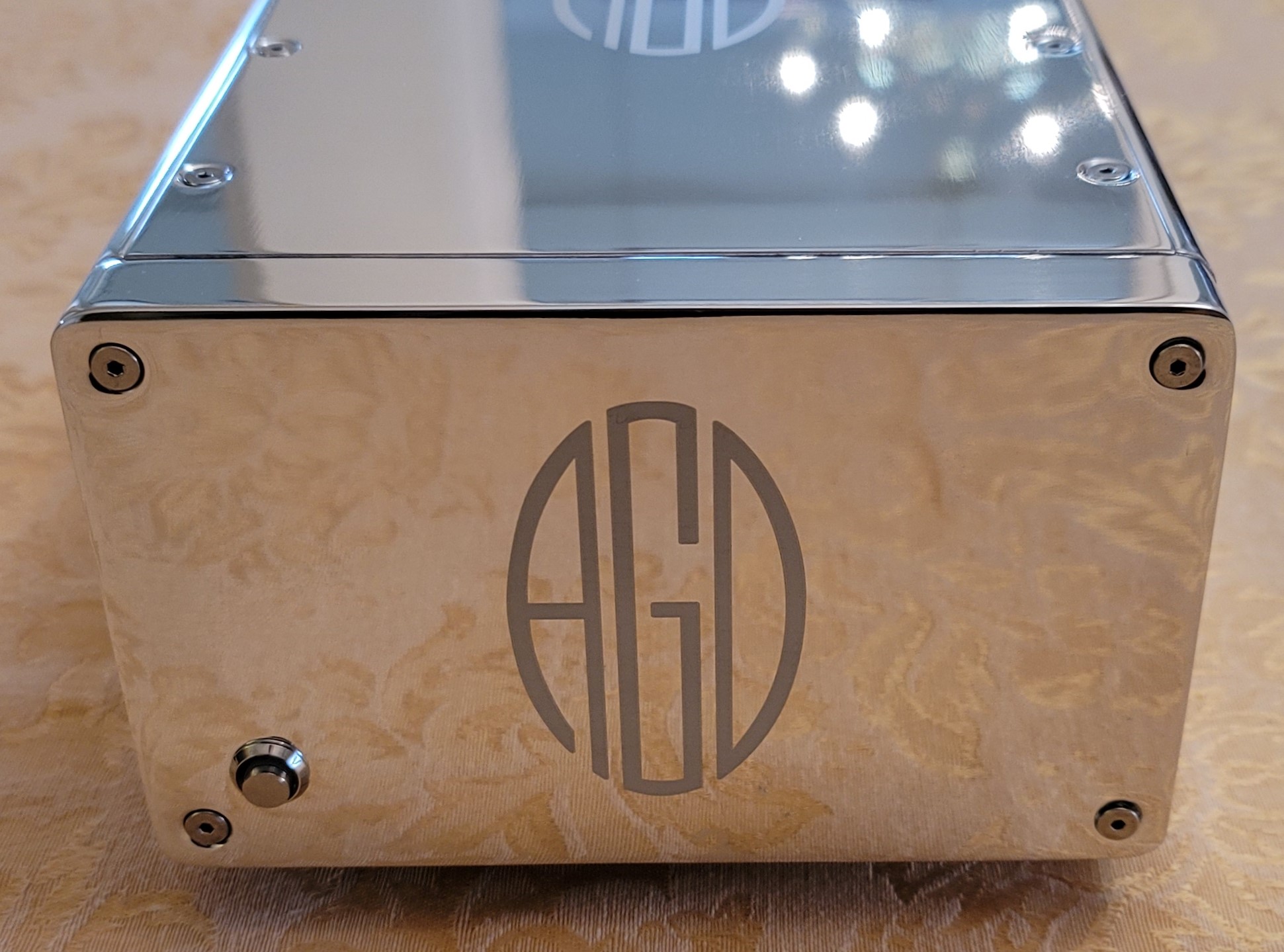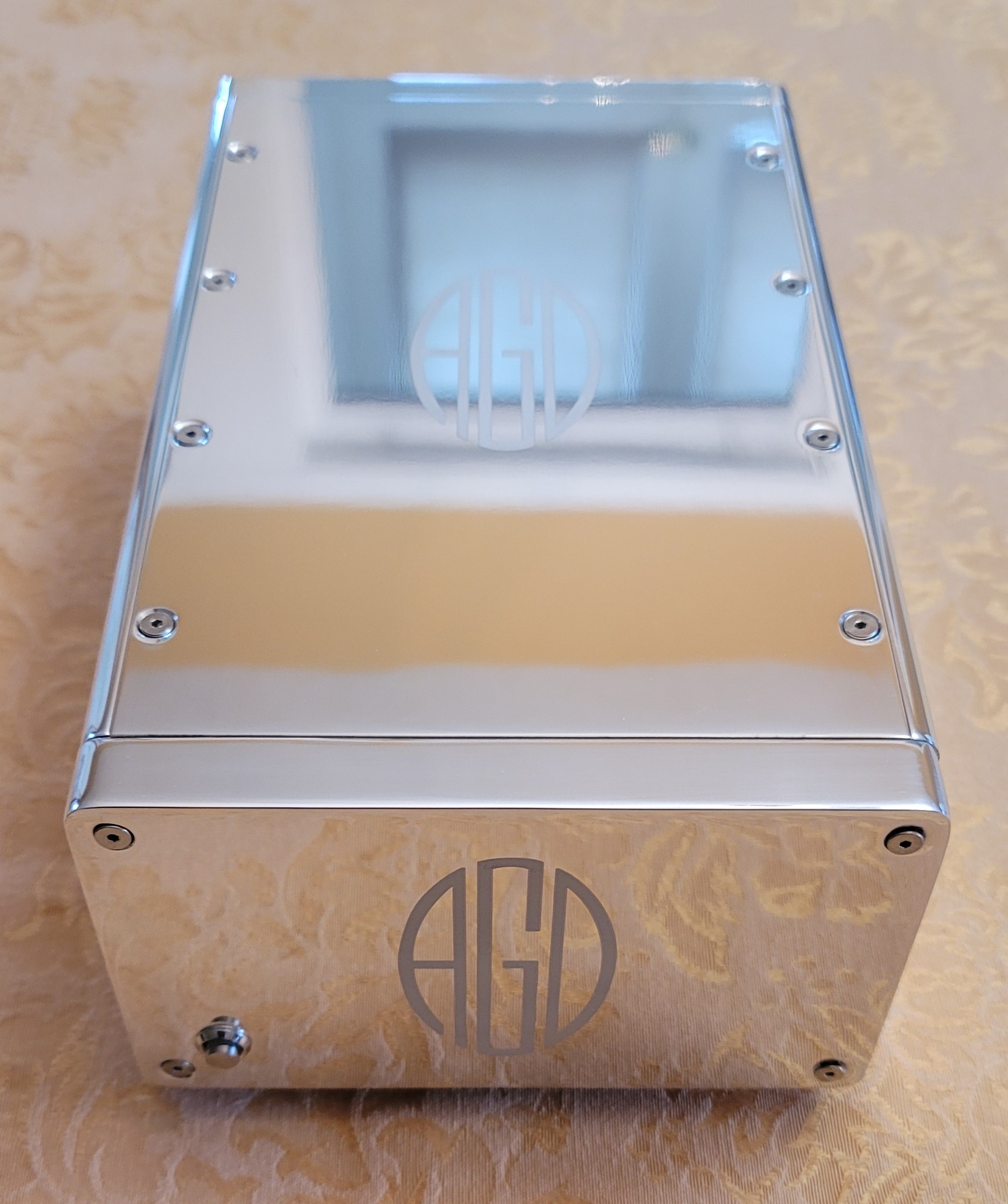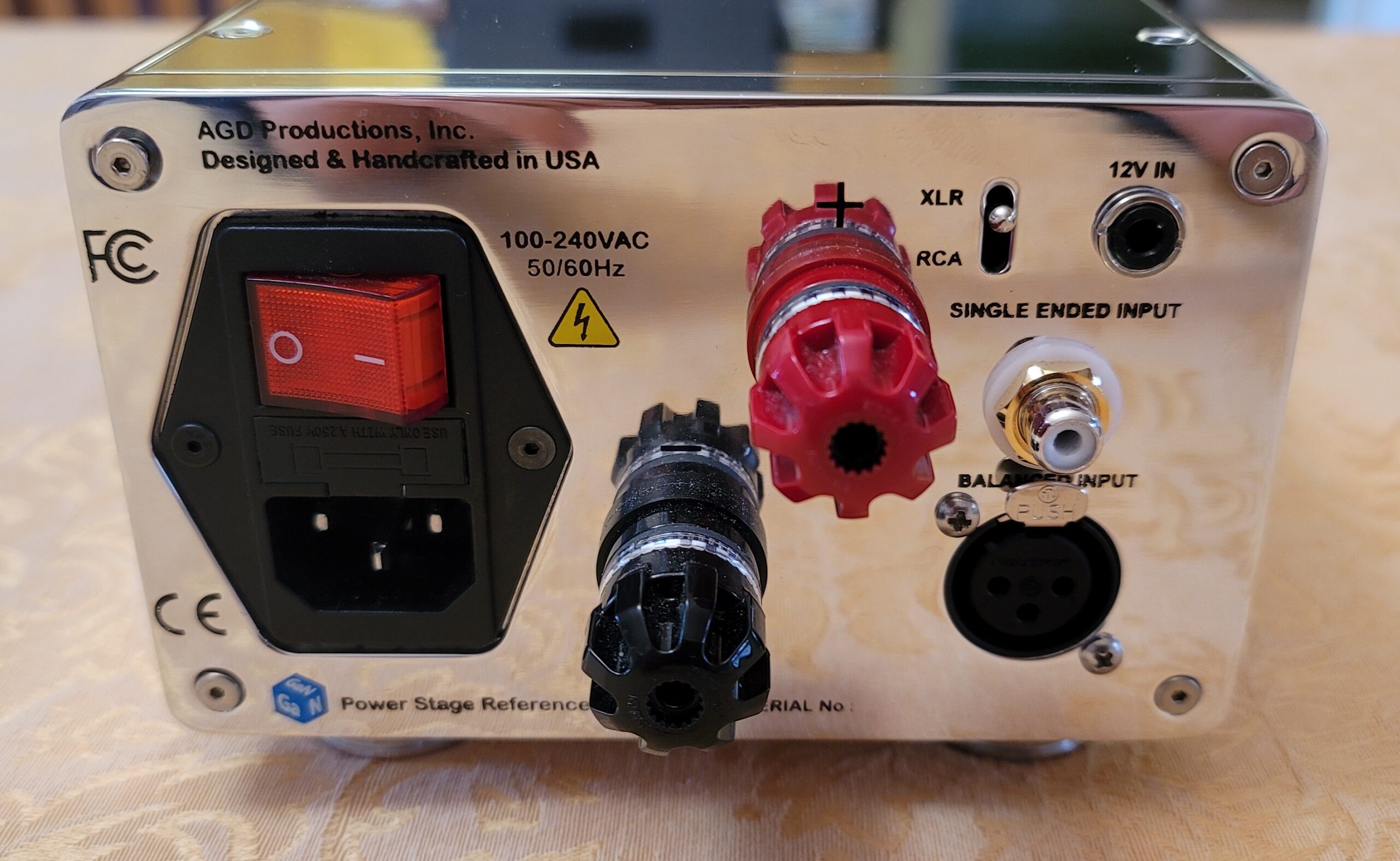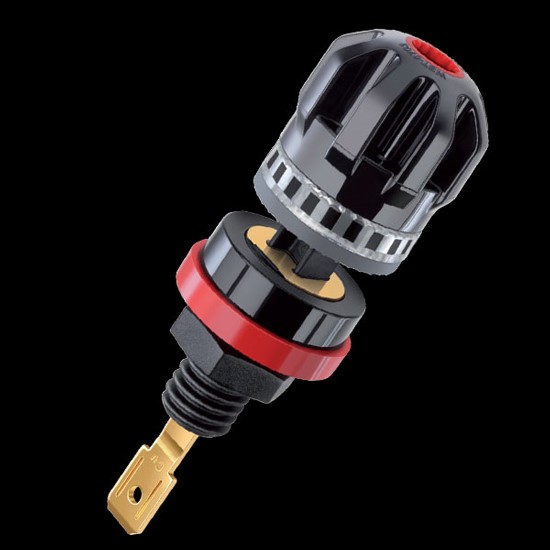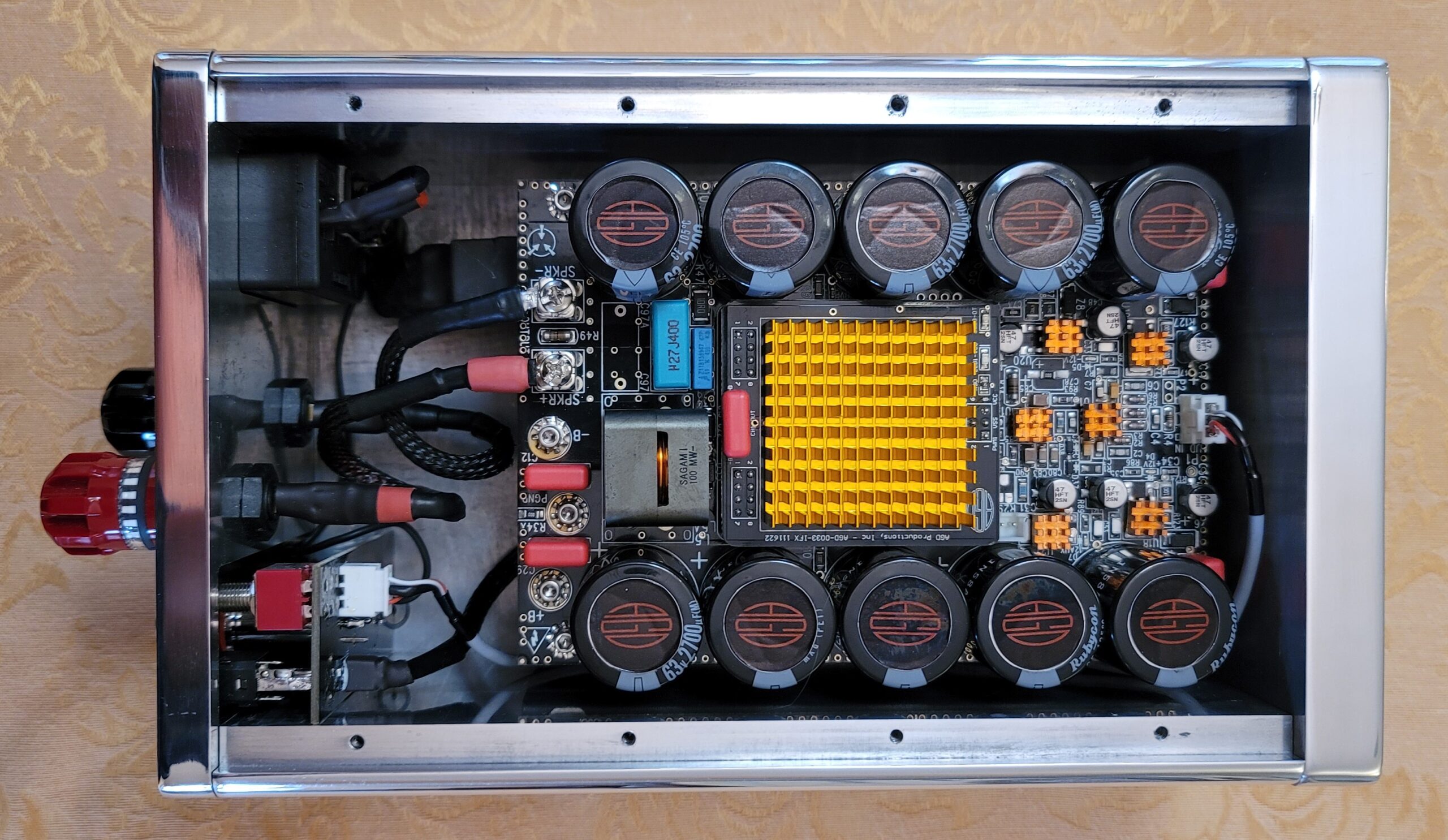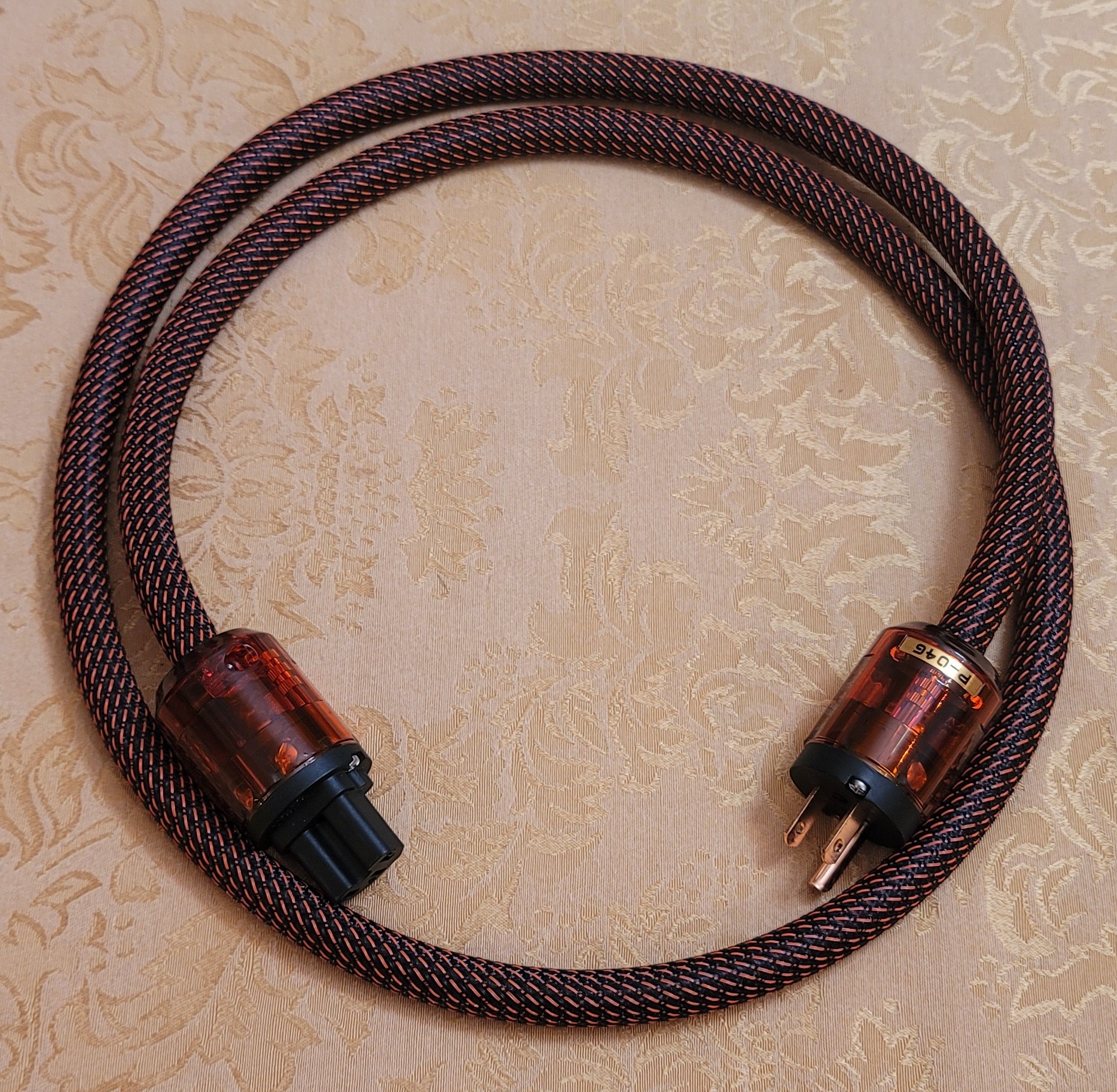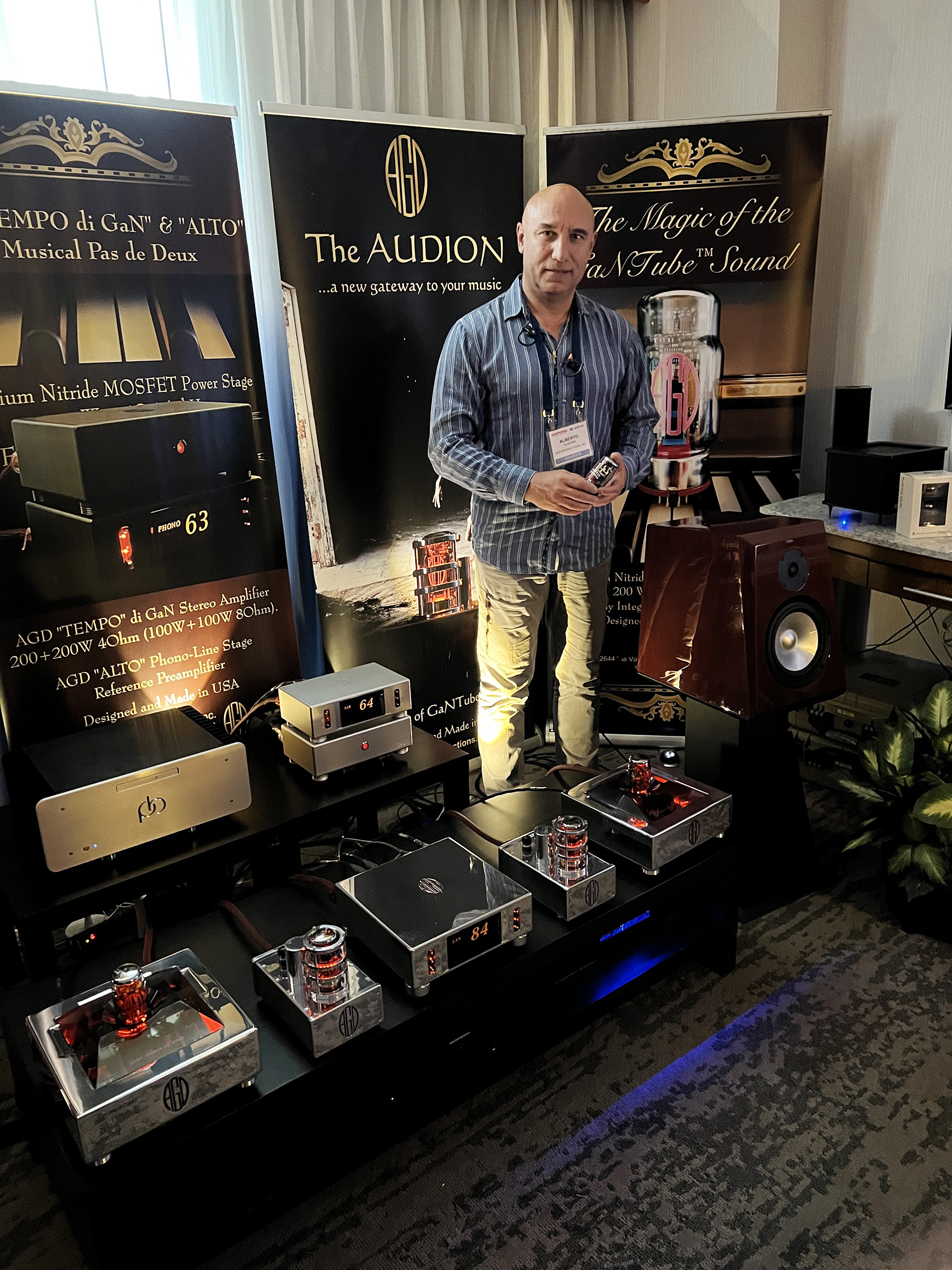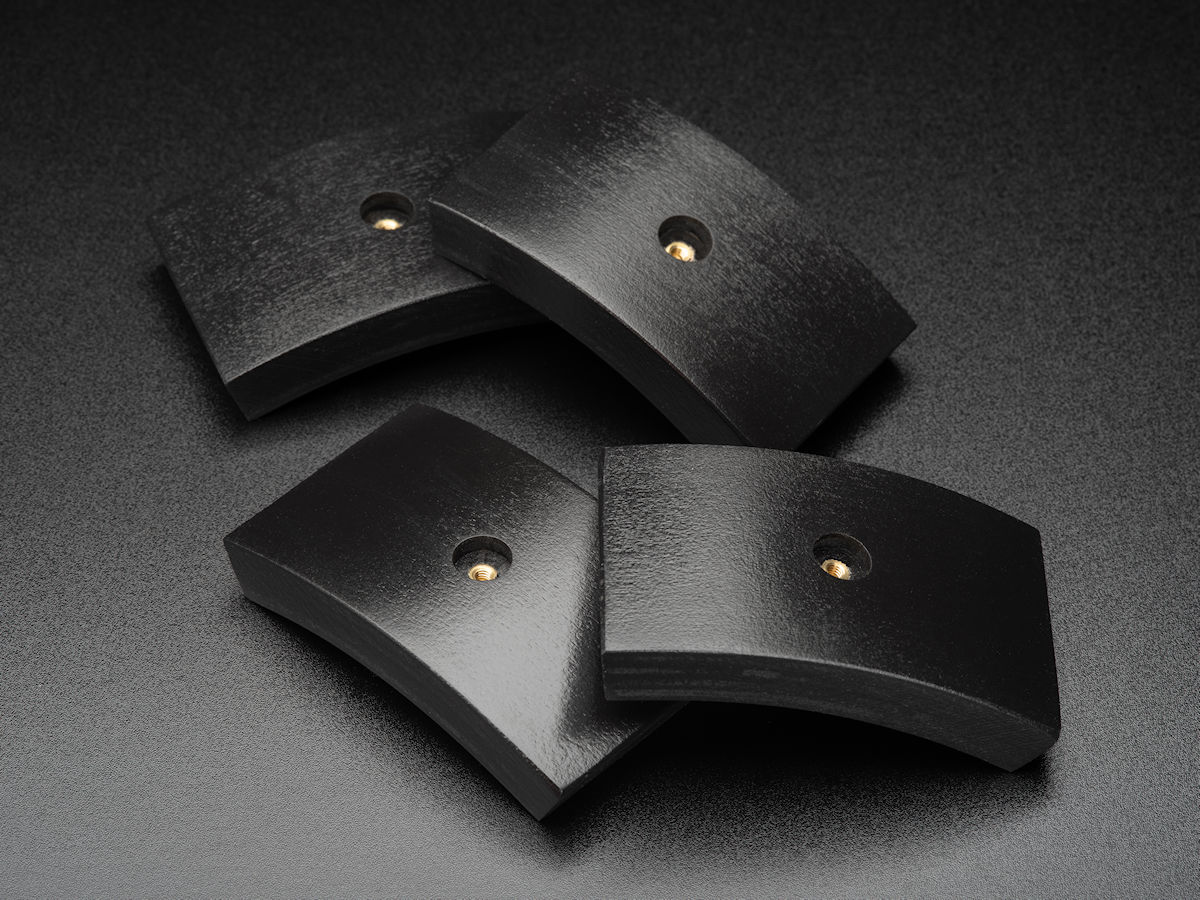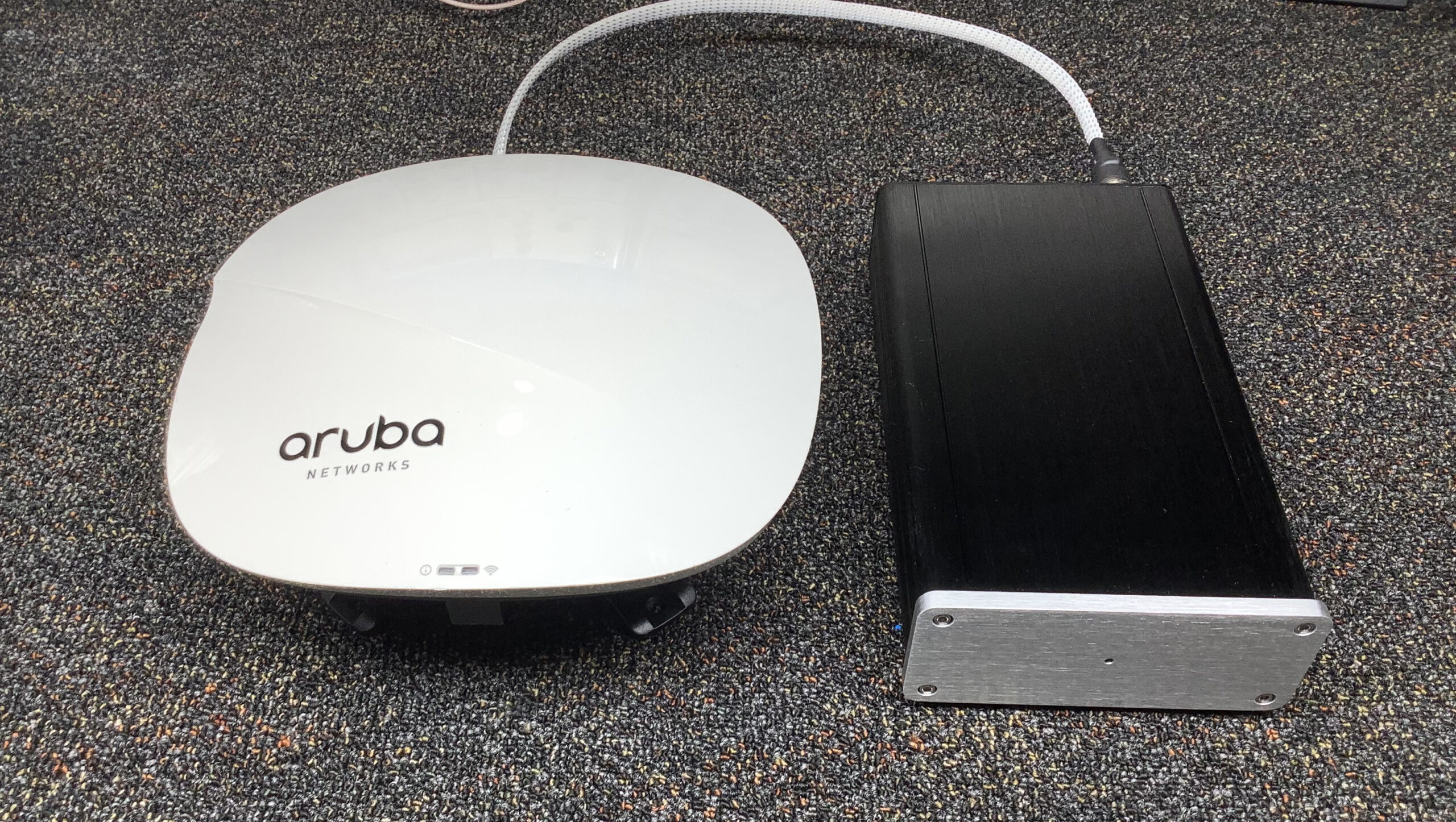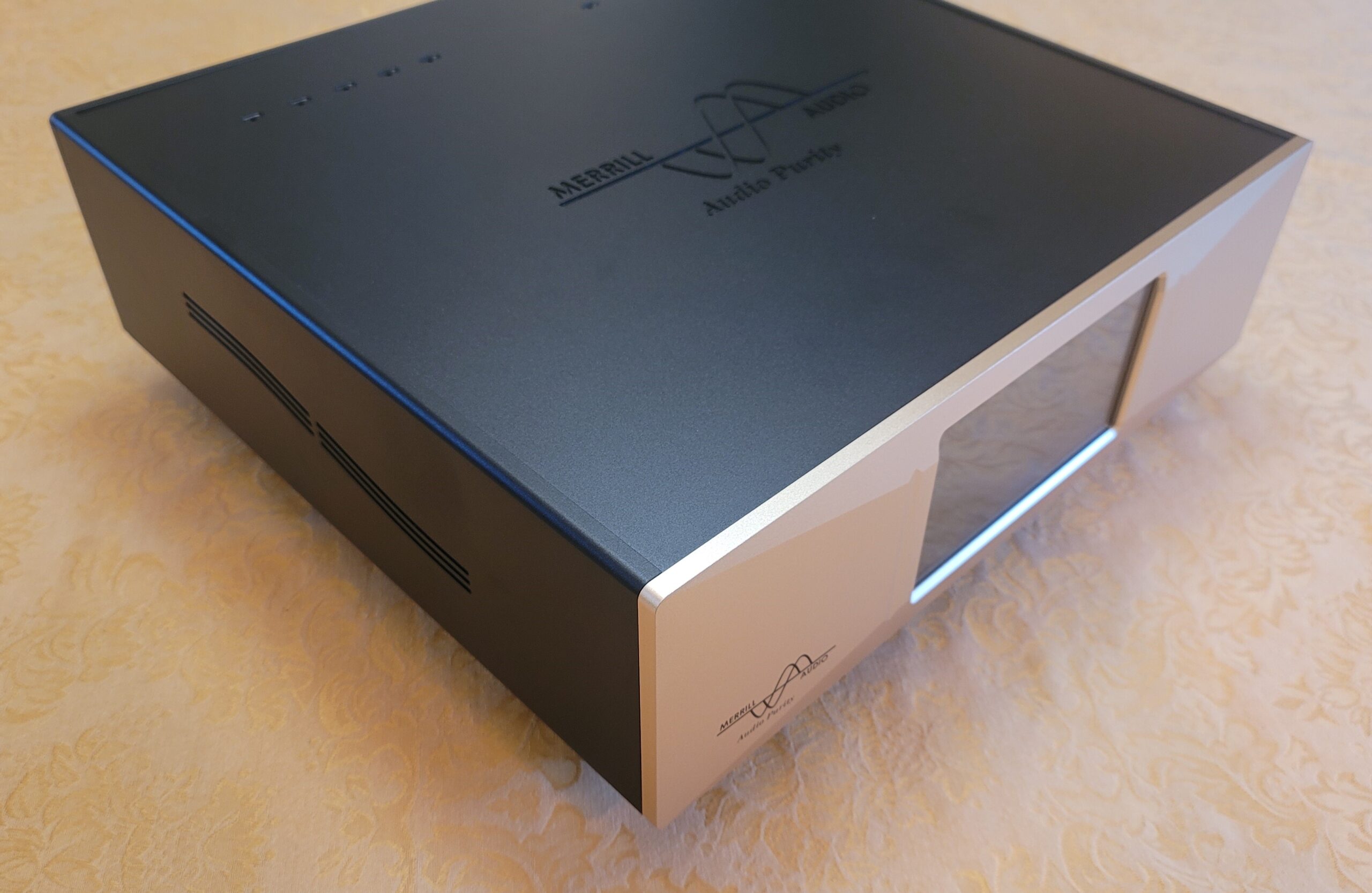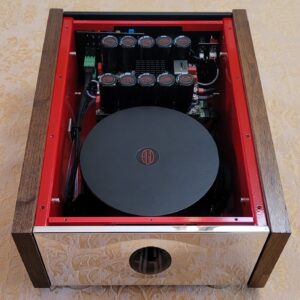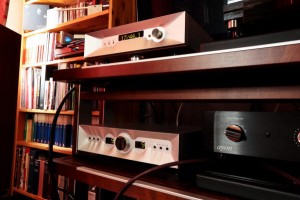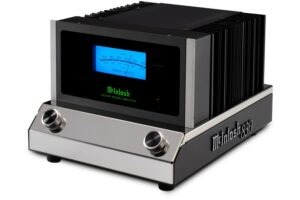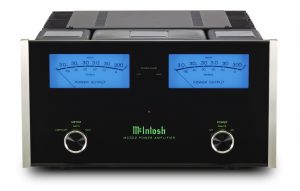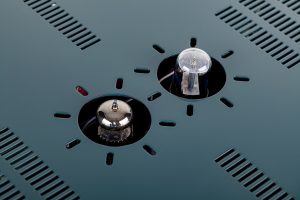Dean Waters: portrait with a cigar. SeaTac, WA, Pacific Audio Fest, 2023
For the last few months, I've been listening to and delighting in a pair of AGD Duet monoblock amplifiers. These are the newest addition to the AGD product line, and are rated for a very solid 150W @ 8 Ohms (300W @ 4 Ohms). They are each physically encased in a brilliant, polished metal chassis with the AGD logo prominently etched into the front and top of the units. The Duets are also available in an anodized black finish.
Front view. I really like the look of these amplifiers. At just over 5.5" (142mm) and 10" deep (254mm) they are a perfect fit either on top of an equipment cabinet or on a shelf.
Top view. The polished mirror-like shine looks terrific!
Side view. The pattern seen on the side is a reflection of the surface underneath. The reflections are sharp and crisp. AGD's fit and finish is superb.
There is a small push button on/off switch located on the front with a subtle blue LED that surrounds the button when powered on. There is also a master rocker power switch on the back that illuminates with a red glow when switched on. The back of the unit offers both balanced (XLR) and unbalanced (RCA) inputs with a small toggle switch to select between the two. The speaker terminals are from WBT (WBT-0703Cu Nextgen) and are large and easy to work with. They support both spade lug and banana plug type connectors. There is also a standard 1/8" 12v trigger port on the back to automatically power the monoblocks on and off remotely.
Window on the rear (with apologies to Alfred Hitchcock).
Speaker binding post (image courtesy of WBT-USA).
Internally, the Duets feature oversize capacitors to ensure steady and consistent power flow to the GaN MOSFETs that are present in both the power supply and output power stage. At the core of the Duet lies the GaN Sound Module. This is upgradable as new designs become available in the future. This is a feature of all AGD amplifiers.
Inside view. Note the large power supply capacitors along the top and bottom. Also note the center Sound Module board that can be swapped out and upgraded as future technologies are developed and brought to market.
Inside view with covers removed.
Each AGD amplifier ships with a custom-designed power cable.
First of all, I'm extremely pleased with the sounds produced by these amplifiers. The tones from these amps are clean, crisp, without added color, and devoid of noise or other detracting artifacts. There is virtually zero noise floor. At idle, these amplifiers are, near as I can tell, completely silent. There is also a pleasant warmness that is delivered with an equally pleasant sense of staging. More so than I would expect from a Class D amplifier. In fact, these are just as warm and buttery as my KECES 300+ Class A/AB hybrid amplifier, and that's high praise!
I think it's worth taking a look under-the-hood, so to speak, and see just what makes these amplifiers worthy of the praise I'm unabashedly bestowing here. Let's step back and look at various ways that power amplifiers work.
In broad and simple terms, amplifiers are generally referred to as either "linear" or "switched." Further, amplifiers are defined by class. The class of amplifier dictates the general design and architecture used. Ask someone what an amplifier does and they'll inevitably say "it takes a small signal and makes it bigger." Sounds reasonable enough. That's not exactly correct. Sure, the end result is "small signal in, big signal out." But rather than taking the input signal itself and making it "bigger," instead the input signal is used to regulate power from the internal power supply of the amplifier to the speakers. This is why the quality of power supplies within amplifiers is so important. The input signal is basically a method of power control. The output signal is completely generated by the amplifier's power supply. None of the input signal actually makes its way to the output signal. In solid-state amplifiers, power is created and then run through one or more transistors that use the input signal to control the flow of current to the speakers. Now let's review how this is done. This is where the Class of amplifier comes in.
In the beginning….There was Class A
Class A amplifier designs have been around since the beginning of amplified sound. Broadly speaking, power is sent to transistors (and/or tubes) and the input source continually varies the amount of current that flows through the transistor from the power supply to the output terminals. Simple, and beautiful. These "linear" amplifiers are truly analog devices in every sense of the word. Audiophiles love them. However…..there's a problem. A big one at that: Efficiency. Turns out, transistors are highly power efficient when they are either fully ON or fully OFF, and terribly inefficient when they are between fully on and fully off. This is exactly what class A does. The transistor(s) are always in a state somewhere between ON and OFF. The transistor power flow mirrors the input source signal, which exists in a state somewhere between 0% and 100%. Only about 20% of the power drawn by a Class A amplifier makes it to the speaker, the remaining 80% is converted into heat. Class A amplifiers tend to be huge, heavy, with large heat-sinks, and they can double as room heaters! Thus, we use Class A amplifiers for low power applications like preamps, headphone amps, and as the first few watts of power in hybrid amplifiers.
To try to help solve this, Class A/Bs were created. These use a pair of transistors (or transistor banks) where each transistor controls half of the wave cycle of the input signal. Thus each transistor only has a 50% duty cycle and doesn't generate as much heat. The problem is that if you have double the transistors each producing half as much heat, the net effect is nearly the same as one transistor producing the same amount of heat. There's also the problem of the crossover point where one transistor is making way for the other. But that's a topic for a future article…. Suffice it to say that A/Bs don't exactly solve the efficiency problems either.
They are more efficient than Class As, but not by much.
Class D to the rescue!
Class A, and Class A/B amplifiers are considered "linear" in that the transistors are always on and that they mirror the input signal to control power flow to the output terminals. What is needed is to develop a way to get proper sound while only switching the transistors from fully ON to fully OFF in rapid succession. This would, in theory, solve the efficiency problem and allow for smaller amplifiers with smaller power supplies that use most of their energy to drive speakers and not waste energy as heat. The Class D amplifier was invented back in the 1950s, but didn't become commercially available until the late '70s when silicon-based MOSFET's become available. A MOSFET (metal–oxide–semiconductor field-effect transistor) is a type of modern transistor that is used in nearly every modern application known today. Very small, and very efficient. In personal computers, MOSFETs handle all the power delivery. Without them, we wouldn't have the super-thin laptops and tablets (not to mention cell phones) we use today. Modern Class D amplifiers using MOSFETs are up to 95% power efficient while only losing 5% of the power draw to heat.
Now the question, how do you get sound that represents music when running power from the amps' power supply to the speakers through a transistor that's only ever fully ON or fully OFF? The secret is you need to do it fast. Very, very fast. This is why Class D amplifiers are referred to as "switching" amplifiers. Power is "switched" on and off to the speakers at a rate many times faster than the highest sound frequencies being amplified. How does this happen?
A circuit referred to as a comparator is used. There are two signals in play here. The first signal is the input signal being fed into the amplifier from the source device (DAC, streamer, preamp, etc). There is also a triangle waveform signal that is generated within the amplifier. The speed of this signal is critical, and we'll get to that soon enough.
Now, both of these signals (the sound source and the internally generated triangle wave) are fed into the inputs of a comparator circuit. The comparator continually compares the voltage from these two signals. When the voltage of the sound source signal is greater than the triangle signal, the comparator outputs a "high" voltage that triggers one set of MOSFETs, supplying positive current to the speaker (compression). Within the comparator, when the sound source voltage drops below the triangle wave voltage, a "low" voltage is sent that triggers a different set of MOSFETs that supplies negative current to the speaker (rarefaction). Do this fast enough and you get sound!
There are two basic challenges with this Class D approach. The typical Class D can't replicate the input sound waves precisely. There is a bit of overshoot and undershoot when comparing the source signal against the amplified result. Whenever you modify the shape of a sound source, you introduce distortion. Technically you're introducing overtones (aka "partials") at very high frequencies that we perceive as noise. To compensate, Class D amplifiers make use of sophisticated low-pass filters that remove these high frequency artifacts, leaving the lower frequencies (frequencies within human hearing range) intact. Even with this, however, the output signal doesn't quite match the source and we can lose some warmth and life in the music. Class Ds often get quoted as sounding "digital" or "harsh" or "cold". We often think of Class D's as "digital" amplifiers because there is a discreet frequency that is generated within the amplifier—the triangle wave mentioned above. And that signal has a set frequency, measured in kilohertz (kHz). The faster the kHz, the better the end result. A typical Class D can often run at 200kHz (this is common). That means the triangle wave that is being used to compare against the sound source signal is a 200kHz signal. However, the comparator that makes the comparison between the source signal and the triangle wave is an analog device. It doesn't run at a set clock-speed. Rather it continuously compares the two signals and outputs a discreet voltage as a result of the comparison. This brings up a new term: Pulse Width Modulation. The signals being sent to the MOSFETs can be considered pulses. The input signal is used to vary the width of those pulses, which creates the sounds we hear from the amplifier.
Alberto Guerra of Alberto Guerra Design (AGD): a portrait of the man and his works. AXPONA 2023, Chicago, IL. (Photograph and image processing by David W. Robinson)
OK, now back to the AGD Duets!
Considering all of the above, if I had to distill why the AGDs perform so well, it would be speed. Or, more accurately, the high refresh rate of the amplifier. Even more specifically, the high rate of the triangle wave and subsequent refresh rate of the comparison of the triangle wave to the source signal. Here's the thing: While many quality amplifiers operate between 200kHz and 400kHz, the AGD's amplifiers operate at a staggering 800kHz. What does this mean? The internal triangle wave generated by the amplifier, and subsequently fed into the comparator is two to four times faster than that of other comparable amplifiers. What does THAT mean? It means that the comparison and subsequent pulse width modulation (remember that term?) is much more precise. The potential overshoot and undershoot of the amplified waveform compared to the original source is reduced by an order of magnitude. This precision is where the warmth, the presence, and the life comes into the reproduction of music. This also means that the filters have less high-frequency noise to filter away and the remaining signal is left truer to the original. That is the best we could ever ask of a quality amplifier.
As to how AGD can accomplish this comes down to materials used. A primary claim to fame of AGD is their use of Gallium Nitride (often referred to as GaN). What separates GaN from other materials commonly used in electronic designs, including amplifiers, is what's known as "bandgap," which is a measure of how well a material can conduct current. Gallium Nitride has a bandgap that is roughly three times that of standard silicon, which makes it ideal for use in high frequency and high-power applications. Because GaN is such a good conductor, it is also highly efficient. Very little power consumed by the GaN transistors is lost to heat. It is this which allows for the AGD amps to run at such a high frequency. The use of standard silicon or other materials wouldn't be able to effectively handle the increased operating frequency.
The design decisions by AGD to use Gallium Nitride and to increase the frequency were wise choices. The effects of this are immediately apparent to the listener. All the warmth and beauty that is usually available with Class A amplifiers is here with the Duets, without the drawbacks. There is no sense of harshness or the brittle sound that so often is associated with Class D amplifiers. The high efficiency, great sound, and simple elegant design of the chassis makes these a clear winner, and more than worthy of consideration.
They were an immediate treat to the ears right out of the box and then continued to improve with use and break-in. I'd say I have about 200 hours of use on these so far and I simply adore them.
Now that they've been returned to AGD, I miss them a lot.
Specifications:
Nominal Output, 20Hz to 20kHz @ 4Ω: 300W
THD+N 10W/1KHz: <0.005%
Maximum Output Power at 0.1% THD+N, 1KHz, 8Ω: 150W
GaN Power Module PWM Frequency: ~800kHz
Dimensions: 10"x5.6"x4.0" (254x142x100mm)
Weight: 8.25lbs (3.75kg)
MSRP: $11,500 (per pair)
Equipment list used for this review: (borrowed items are in bold)
AGD Duet monoblock amplifiers
Mola Mola Tambaqui DAC
Vivid Audio Kaya 90 loudspeakers
QLN Signature loudspeakers
Kubala-Sosna Realization Series speaker cables
RSX Technologies Beyond Series power cables
RSX Technologies Benchmark Series Interconnect cables
Sony UBP-X800M2 CD/SACD transport
Windows™ PC w/ Audirvāna - DSD streaming server
PS Audio PowerPlant 15 power regenerator





